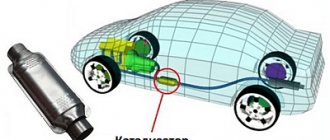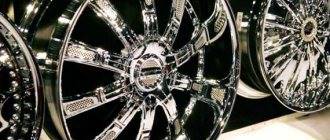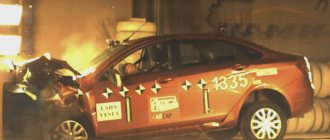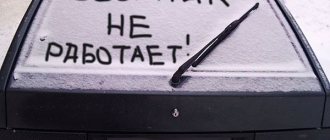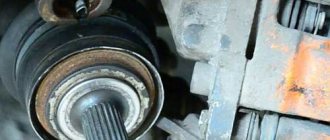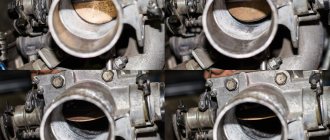Car body welding
The body is the main component of any car, requiring careful care, timely inspection and repair, one of the types of which is electric welding with your own hands. In garage conditions, welding a car body with your own hands is quite doable if you have a carbon dioxide semi-automatic machine capable of welding with wire. It allows you to weld sheets from 0.8 to 6 millimeters. Using a semi-automatic machine, you can patch any holes, weld new parts (spars, sills, wings), and straighten dents.
Do-it-yourself car welding
Carbon dioxide under pressure is supplied to the welding zone, displacing ordinary air, thereby protecting the metal from excessive oxidation. This allows you to preserve metal particles in a larger volume, so it does not burn, but only melts.
If you replace carbon dioxide with argon, you can even cook non-ferrous metals - stainless steel, aluminum or alloys of other metals. In this case, it is important to use the same filler wire from the same metal - aluminum or stainless steel.
Preparing metal for welding
An electric welder performing manual arc welding must prepare the metal for welding before starting work. Body areas and body parts to be welded must be thoroughly cleaned of paint, rust, oil and other contaminants. The advantage of semi-automatic welding is the mechanized supply of a consumable electrode, high speed of welding of thin sheets of metal, reducing the zone of thermal influence on the parts being welded, which leads to an increase in the quality of the weld both externally and in terms of mechanical properties, reducing material consumption and metal deformation.
Depending on the availability of the parts to be joined, their purpose in the body structure, the structural arrangement of the unit and the thickness of the parts to be joined, welding a car with your own hands can be done with an intermittent or continuous seam. An interrupted weld can be used on thin sheet metal if there is a wide gap between the parts being joined, which is required to prevent the risk of burn-through. Continuous seam welding is performed when joining parts end-to-end.
Reducing heat transfer to the metal can be achieved by periodically applying current and welding wire. The ratio between the welding time and the break is selected depending on the thickness of the parts being joined and the size of the gap between them. During the break, the weld pool cools, thereby eliminating the possibility of burn-through.
Do-it-yourself arc welding of the body is carried out as follows:
1. Before using electric welding, you need to check the network for load capacity, in other words, you need to be sure that your wiring will withstand the load of the welding machine. Only after this can you begin preparing for welding.
2. “Charge” the semi-automatic machine with welding wire. This can be done this way: first remove the gas nozzle of the welding torch, then use a wrench to unscrew its copper tip, then remove the pressure roller with the wire and set the required current polarity. When welding with flux-cored wire, you need to install the plus on the clamp and the minus on the torch. If you use regular wire, the polarity will need to be changed - plus on the torch, and minus on the clamp.
After this, you need to manually insert the end of the wire 10 - 20 cm into the feed channel and bring in the pressure roller, keeping the wire from falling off. Be sure to check that the wire is in the groove on the drive roller.
After completing all these steps, you can connect the semi-automatic machine to the network and press the key on the handle of the welding torch. First, gas will be supplied, and then the supply of welding wire and current will turn on. Then you need to select and put the required copper tip on the wire, tighten it and install the gas nozzle.
When welding work in the body, all parts except the front are usually welded, since the load on it is minimal. The exception is vehicles in which greater emphasis is placed on the front suspension, namely, the place where the front “legs” are attached to the cross beam must be thoroughly welded. You can weld the floor on both sides, just do not forget to treat the welded seams with a special primer, this is very important. The front part of the car, that is, the fenders and hood, is usually not boiled, but careful processing of the seams of the pan, pillars and rear part is required.
Compositions for exposed surfaces
Protective agents for exposed surfaces can in turn be divided into:
p, blockquote 19,0,0,0,0 –>
- coatings that provide long-term protection;
- coatings requiring periodic re-treatment.
Coatings that provide long-term protection are mastics based on rubber, bitumen or polymers. Their main advantage is that they are resistant to stones and reduce noise in the cabin. They can be sprayed using a special gun (shutz gun) or applied with a brush. Their task is to seal the bottom from the environment.
p, blockquote 20,0,0,0,0 –>
Most long-term underbody protection products have a bitumen base. Bitumen based products are non-curing. They remain elastic for a long time and do not become fragile.
p, blockquote 21,0,0,0,0 –>
The anti-gravel coating contains rubber and polymers, hardens, but remains elastic. Small stones bounce off it. You can read the article “features of applying anti-gravel”, which describes in detail its properties, preparation for application and application.
p, blockquote 22,0,0,0,0 –>
Coatings that provide long-term protection do not penetrate deep enough into metal folds and hard-to-reach areas where corrosion typically occurs. Such products are effective if applied to a clean, dry surface, preferably a new one. If for some reason such a coating is damaged, then moisture will enter through this damage, creating a “pocket”. As a result, corrosion will develop inside the protective coating and will not be noticeable. Even bitumen coatings can become hard and brittle over time and crack. Water can get inside through cracks.
p, blockquote 23,0,0,0,0 –>
Coatings that require periodic re-treatment are The protective film of these components, unlike the film formed by long-term compounds, allows the moisture remaining inside to evaporate. This property helps prevent the appearance of new rust.
p, blockquote 24,0,0,1,0 –>
The wax is not harmful to health and can be used on the underbody even inside the cabin. Wax-based formulations, unlike oil-based formulations, can dry out over time.
p, blockquote 25,0,0,0,0 –>
Oil-based compositions can be considered the best anticorrosive, as they have good penetrating ability, displace moisture and do not dry out. Oils can soften the factory underbody protection.
p, blockquote 26,0,0,0,0 –>
Protective coatings based on wax and oils do not provide mechanical protection to the bottom, are not durable and require periodic renewal.
p, blockquote 27,0,0,0,0 –>
Do-it-yourself car welding - underbody repair
One type of body repair is also welding the underbody of a car with your own hands, usually carried out when it is necessary to restore the integrity of damaged elements. When undertaking welding work on the underbody, it should be taken into account that in addition to smooth and fairly clear seams in place, it is also necessary to carefully observe the temperature regime, which helps to preserve a certain structure of the seam and neutralizes the possible harmful effect on the metal of the underbody of a welding machine located near the repair site .
When choosing a metal to make a patch for the bottom, you must remember that a sheet that is too thin will be unreliable, and a material that is too thick may be relatively difficult to process. As a rule, to repair the underbody of a car, metal with a thickness of 1.5 to 2 mm should be used. Metal cutting by electric welding must be carried out in compliance with optimal conditions in order to avoid deterioration of the technological qualities of the material.
It is better to weld the bottom with two people. The fact is that the metal layer must be evenly distributed, and it is almost impossible for one worker to control this, since the probability of poor-quality welding is high. After welding, the edges of the patch must be ground and treated with primer or epoxy resin to ensure tightness and reliable protection of the joint.
Welding work on the bottom
An example of “threading” wire into a welding machine.
If damage to the integrity of the bottom elements is detected, then repair work on the bottom is necessary. This work requires smooth seams and compliance with a certain temperature regime. This allows you to avoid harmful effects on the bottom material and maintain the required seam structure.
It is very important to choose the right material for making patches on the bottom. You cannot use metal that is either too thin or too thick. In the first case, the patch will be unreliable, and in the second, the metal will be difficult to process. The optimal thickness is 1.5-2 mm. To maintain the technological characteristics of the material used, you will need to adhere to the optimal operating mode when cutting metal.
Table of welding modes in carbon dioxide.
It is recommended that two people work together, since it is almost impossible to control the uniform distribution of the metal layer on the bottom alone. Upon completion of the welding work, it is necessary to sharpen the edges of the patch and coat it with a special primer or epoxy resin. This will ensure protection and sealing of the joint.
The bottom may become deformed over time. Dents increase the likelihood of corrosion. You can eliminate them by tapping the bottom with a mallet. This work must be done evenly. They start from the middle of the dent.
Many materials used in bottom welding are highly flammable. Therefore, it is not recommended to weld it if you do not have at least basic welding skills. In this case, it is recommended to contact a professional.
Basics of arc welding when repairing engine components
Semi-automatic is also the most suitable welding machine for household electric welding of engine elements, but only with the mandatory use of argon. Using argon welding, it is quite possible to weld almost all metals used in a car engine: cast iron, stainless steel, aluminum or ordinary steel. A list of engine parts that can be repaired by welding is presented below:
- Cylinder blocks.
- Valve guides.
- Cylinder heads.
- Intake valves.
- Intake and exhaust manifolds.
- Covers and caps for chambers for adjusting ignition timing.
- Water and oil pumps.
- Pistons and piston pins.
- Valve seats and inserts.
- Pipelines and much more.
The heart of the car
Car muffler welding
The semi-automatic welding machine is also successfully used for muffler repair. To repair a broken or rotten car muffler, the following actions are recommended:
- Cut a sheet of metal of the required size and apply it to the damaged area.
- Sand the edges of the damaged area and the applied repair material with sandpaper.
- It is necessary to apply the patch to the thickest parts of the muffler - this is done so as not to burn it.
- Select electrodes with a diameter of two mm and adjust the current of the welding machine to them.
- Before performing welding work, be sure to disconnect the battery terminals.
- Welding must be performed with the welding arc separated, moving the electrode from thick metal (patch) to thin metal (muffler material).
- The resulting weld seam should be hammered away from slag and visually checked for the presence/absence of pores in it. If they are not there, then everything is in order and the muffler can continue to be used. If there are pores, you need to boil them and put another seam on top of the first one.
Operating principle and theory of semi-automatic electric welding:
If, after our advice, you still haven’t decided to work on your own, we recommend that you watch video material on the topic, electric welding lessons for beginners.
The car body is an important part of the vehicle, like other components or parts. The body is at risk, being a buffer in contact with the external environment - the inevitable mechanical impact of surrounding objects, other vehicles and objects in road accidents is guaranteed to lead to breakdowns and disruption of the shape of parts and loss of external attractive appearance. Don’t forget about the aggressive influence of the environment - moisture, dirt and salt cause corrosion spots and cracks. In all of the above cases, car body repair is required.
How much does the bottom of a VAZ 21099 cost?
Fuel tank flap in color for VAZ 2108, 2109, 21099, 2113, 2114
The lower part of the radiator/TV frame (platform for crabs) on VAZ 2108-21099, 2113-2115
Front left fender in color for VAZ 2108-21099
Right floor threshold connector (jack) for VAZ 2108-21099, 2113-2115
Front left floor threshold connector (jack) for VAZ 2108-21099, 2113-2115
Repair part of the wind window frame, right (large) for VAZ 2108-21099
Sunset rear left wing (long) on VAZ 21099
Threshold amplifier (short) for VAZ 2108-21099, 2113-2115
Rear right floor threshold connector (jack) for VAZ 2108-21099, 2113-2115
Right floor cross member for VAZ 2108-21099, 2113-2115
Left floor cross member for VAZ 2108-21099, 2113-2115
Threshold connector right for VAZ 2108-21099, 2113-2115
Threshold connector left for VAZ 2108-21099, 2113-2115
Front right fender in color for VAZ 2108-21099
Tailgate hinge for VAZ 2108, 2109
Radiator frame panel assembly (cataphoretic coating) for VAZ 2108-21099, 2113-2115
Tailgate in color for VAZ 2108, 2109
Lower left mudguard panel reinforcement (herring) for VAZ 2108-21099, 2113-2115
Left outer wheel arch for VAZ 2108-21099
Sunset rear right wing (long) on VAZ 21099
Front left floor spar for VAZ 2108-21099, 2110-2112, 2113-2115
Front floor panel (cataphoretic coating) for VAZ 2108-21099, 2113-2115
Front left wing mudguard without spar (burdock) (cataphoresis coating) on VAZ 2108-21099, 2115
Right outer wheel arch for VAZ 2108-21099
Front left door for VAZ 2108 in color
Rear left floor threshold connector (jack) for VAZ 2108-21099, 2113-2115
Left headlight mounting bracket for VAZ 2108-21099, 2113-2115
Middle floor panel (cataphoresis coating) for VAZ 2108-21099, 2113-2115
Radiator frame cataphoretic coating for VAZ 2108-21099, 2113-2115
Front right wing mudguard without spar (burdock) (cataphoretic coating) on VAZ 2108-21099, 2115
Lower right mudguard panel amplifier (herring) for VAZ 2108-21099, 2113-2115
Left spar amplifier for VAZ 2108-21099, 2113-2115
Front seat side bracket for VAZ 2108, 2109, 21099
Upper radiator frame cross member (cataphoresis coating) for VAZ 2108-21099, 2113-2115
Requirements for welding a car body
Welding a car body is a labor-intensive process, be it arc, spot or other type of welding. In any case, it requires a high-quality welding machine for automotive body work and a highly qualified welder - only this combination guarantees a satisfactory result. Lack of proper experience and a good welding machine does not allow you to achieve an accurate and thin seam. Body welding work should be carried out in a specially equipped room, where there is a connection point to the network with the appropriate parameters of frequency, voltage and current, a gas source, etc. Welding a car body with your own hands is possible only in simple cases and for body repairs in places where the aesthetics of the seam is not so important.
A professional approach to body processing in an equipped service station allows you to obtain a weld seam with the necessary criteria:
- the type of seam is selected depending on the location of the damage;.
- taking into account the characteristics of the metal, the type of welding is selected;
- welding repair method - gas, manual arc, semi-automatic, laser - is selected individually in each case.
Indeed, there is no universal option; car elements after repair are exposed to different forces and are made of different materials. Spot welding is used in the vast majority of cases for repairing wings and sills, while an overlap connection will be optimal for elements under high load. If it is necessary to partially replace a part, then it is reasonable to use a butt joint, for example, when patching holes on the bottom of a car.
Timely car diagnostics allows you to identify damage at an early stage, which makes it possible to solve the problem without serious financial costs.
Bottom repair - patching holes, making sound insulation
Contents
Bottom repair - patching holes, making sound insulation
Selecting replacement parts
UNDERBODY REPAIR
Do-it-yourself: Processing the bottom of the outside of a VAZ-2107
Hi all! Last year, I accidentally discovered wet noise and cracked vibration insulation under the front seats; winter was coming, so there was only enough time to replace the wet felt. This year I decided to completely inspect the bottom, and at the same time replace the standard Shumka with vibration and add noise to the engine shield, which should have been done when purchasing the car. Since I had already noticed one rotten area in one place on the bottom, I bought in advance at the car market a sheet of metal for patches, 1.4 mm thick, according to the seller. There was also standard 0.8 mm metal, but it seemed a little thin, and the difference in price was small. The sheet was immediately degreased, matted with P280 sandpaper, primed with epoxy primer, then insulated with regular primer and finally coated with 3in1 rust-resistant enamel.
To get to the Shumka, you need to dismantle the front seats and the sofa, remove the shelf under the glove compartment, the console, the sill panels and the seat belt bobbins with locks.
The new felt also turned out to be soaked through, it’s unclear where the water came from again?
The factory Shumka at the rear was also partially wet and had already begun to rot.
The vibration is cracked and peeling in places, especially at the front, there is water and rust underneath.
I scraped it off with a dull chisel and a sharpened spatula, since it had already hardened, so it came off quite well, and I finished it in a couple of hours. The floor underneath appeared to be primed, unlike the doors where it was molded onto bare metal, and was in good condition, especially at the rear, with only a little surface rust in places.
When checking the bottom with an awl, as it turned out, not everything was good. It has rotted over both underbody reinforcements and the jack on the right front, there is sand and rust inside, although the amplifiers are still intact.
At the rear, the floor above the jacks also rotted, and on the left, the threshold was specifically grabbed, in the place where rot was initially discovered on the bottom. The threshold amplifier is completely rotten.
I cut out the rotten metal with a grinder, cleaned out the cavities and coated the inside with heated pushsal, since it couldn’t really be treated afterwards.
Then, I cut out templates from wrapping paper, calculating the overlap on the healthy metal, and then cut out patches from painted sheets using them. Before welding, I removed the controller and battery so as not to burn anything.
First, I grabbed a patch around the perimeter, and then, tapping with a hammer, I welded the seam and, after beating off the slag and cleaning it, covered it with seam sealant, which I used in the anti-corrosion test. Although, of course, it would be better to paint it first.
Read, it may come in handy: Installing a central lock on a VAZ 2107 with your own hands (photo, video)
I used a 2 mm electrode, since I couldn’t find a smaller one on sale. In principle, it cooks normally, there were burns only in those places where the metal was rotten and was a bit thin. I tried the 3rd one - it’s already burning through.
At the rear left we had to install two patches from the inside and outside; the threshold amplifier, one might say, was absent there, but I think the patches will serve as something of an amplifier.
Then, I completely removed the remaining vibrations with white spirit, cleaned the rusty areas with a flap wheel, etched the rust with a converter and painted it with 3in1 paint with a roller in two layers with intermediate drying.
Just wait until it all dries well.
What type of welding should I use to weld the body?
As stated above, the choice of which welding and which materials are suitable for welding a car body should be done by professionals, as well as which apparatus to choose to implement the process. The car body is made of low-alloy steels with a small titanium content or carbon steels with a carbon content in the range of 0.08 - 0.14%, and such steel, with an average thickness of about 0.8 mm, is excellent for stamping and is resistant to strong tension. As for the types of welding repairs, the specialist chooses from the following range:
- manual arc welding using a multi-station welding rectifier of the “VDM 1202” type or its equivalent with electrodes with a diameter of 1.6 mm of the UONI 13/45 brand, the weld position is lower;
- gas welding of a car body is performed with a gas torch with an acetylene-oxygen flame and filler wire with a diameter of 0.8 mm, brand Sv-08G2S;
- semi-automatic welding of a car body is also in high demand - it will require a carbon dioxide cylinder and wire with a diameter of 0.8 mm of the Sv-08G2S brand. However, you can weld semi-automatically and without gas, using cored wire or flux-cored wire.
Is it possible to weld a car body with a welding inverter?
The inverter body welding machine with high frequency electric current is used to weld bumpers, additional frames, rear and front winches, bull bars and even fog lights if the customer wanted to place them on the roof of the vehicle. The basic advantage of welding a car body with an inverter is high speed - the work will be completed in the shortest possible time. The inverter has been actively used in the process of creating welds on a vehicle since Soviet times, however, only in areas of the body that do not make any claims to the aesthetic appearance. The resulting seams are reliable and durable, but only on metal with a thickness of over 3 mm. To obtain a high-quality seam with an inverter, it is important to carry out the procedure in a clean room - moisture and dust entering the housing will inevitably affect the quality of the seam.
What problems most often arise
Despite the decline in quality, the body of the "Seven" suffered corrosion in the third year in certain places. These are the sills, supports, side members and wings, because the elements were not hot-dip galvanized.
The front and rear parts of the VAZ 2107 body are protected by a metal bumper, but after the impact load hits the bottom, as well as all the base elements, this leads to the formation of cracks in the protective coating. , When moisture gets in, the bottom begins to rust both inside and out.
The most common problems with the bottom of the VAZ 2107 line:
- It quickly ages from dynamic loads when driving on uneven roads.
- The first spots of corrosion are in cavities and closed pockets.
- If the bottom of the VAZ 2107 is not treated with an anti-corrosion coating, the sheet of steel engine used for the body loses 0.2 mm per year.
- Welds, bolts, window sills, wings. The most vulnerable elements.
Repairs in the lower part are carried out both with and without welding, depending on the degree and depth of corrosion.
Semi-automatic body welding
Which device to choose for underbody repair? A semi-automatic welding machine for body work is optimal for making patches on rust-affected areas of the body. Semi-automatic body welding is performed using a special wire and has deservedly received the title of the most universal means of body repair today. This method allows you to connect metal sheets with a thickness of 0.8-6 mm. Regarding the types of work performed using a semi-automatic machine, it is important to note the following:
- reliable connections on the side members;
- patches in place of corroding metal;
- restoration of the shape using a welding machine in place of ordinary dents.
In addition to connecting the parts, during the welding of the parts, the contact point gets rid of oxygen, and the car body gradually melts, but since semi-automatic welding of the car body is carried out under the control of the operator, the iron does not burn.
Which welding machine is best to choose for creating connections on any type of metal? Of course, this is a semi-automatic welding machine. Indeed, if you use argon rather than standard carbon dioxide for the welding process, then it is also possible to weld non-ferrous metals such as aluminum and stainless steel.
How to digest the bottom 2107
Re-cooking starts with choosing your metal. You need to trim the patch to the desired size. When cooking, you need to completely attach the patch around the perimeter. Replacing the bottom of a VAZ 2107 with steps:
- Clean all problem areas of the floor with a grinder and completely remove rust from the metal.
- The most inaccessible parts of the body are processed by gas welding.
- Cut the metal pieces to the desired size.
- Secure the patches in the right places and weld them with a gas welding machine.
- Grind with sanders, treat with anti-corrosion coating for external surfaces.
If the metal spot is applied to a flat bottom surface, it is better to use a semi-automatic welder for a quick fix. If a part with a bend is welded, it is recommended to use gas welding. The gas welder quickly softens the entire metal sheet, making it easier to bend or hammer into the desired shape.
Required Tools
To repair the bottom of 2107 you need to prepare the following tools:
- Straightening hammers.
- Hacksaw, scissors.
- Bulgarian.
- Semi-automatic gas welding machine or gas welding.
For welding you will need:
- Copper wire, carbon dioxide, if a semi-automatic device is used;
- Calcium carbide, oxygen cylinder, for gas welding installation.
Parts replacement steps
Body repairs in VAZ cars are almost never complete without replacing window sills and side elements. The body inspection scheme also begins with checking the sills as the most vulnerable elements of the body.
Features of welding a car body with an electrode
Manual arc welding
allows you to weld thin-layer metal, but to obtain a neat seam you need not only a welding machine for body work, but also experience. If you have no experience using a welding machine yourself, you can only patch the rusted through areas of corrosion on the bottom - to perform such operations, you can take any materials, the main thing is that they meet the requirements for thickness and reliability. The rest should be left to professionals. This option for connecting metal parts is the oldest and most reliable, and at the same time the most versatile. Moreover, this option can be used for any spatial location of the weld, even in places with limited access. And the wide selection of manufactured electrode grades makes it possible to weld a wide variety of steels - both carbon steels of ordinary quality and high-quality steels with different contents of alloying elements. In this case, the quality of the seam directly depends on the qualifications of the welder, and in general the productivity is lower compared to other welding technologies, but the relevance of a manual welding machine with electrodes is not reduced due to the simplicity and transportability of such equipment.
For obvious reasons, welding a car body with your own hands is cheaper, but not of better quality, especially if the semi-automatic welding machine for body work leaves much to be desired. Having decided to choose a machine for body repair, a qualified specialist will take into account the chemical composition, the thickness of the metal, the location of the welded parts, so that the condition of the thresholds after welding will please the car owner for many years. Indeed, if you have a high-performance welding machine for body work and competent specialists in an equipped room, then it will not take much time to repair the body. So don’t skimp on your car and your own safety - entrust your vehicle to professionals who have everything you need for auto body work.
The body of almost any modern car can be in active use for 10-15 years, before the onset of active corrosion processes. Of course, this is possible in the case of high-quality care and absence of damage (and if there is any, with high-quality repairs). However, the need for repair work using welding may be required not only when corrosion develops, but also, for example, as a result of an accident. Let's look at the technologies for carrying out various types of work so that the reader can imagine how possible it is to weld a car body with your own hands.
How the body is welded at the factory
As you know, the finished body is not cast at all, but a number of parts are stamped from tin, which are then welded together into a single body. Of course, the process occurs, in most cases, automatically, using robots. However, the technology itself is very different from what can be seen in car repair shops or in factories working with metal structures.
The typical welding method, where the weld is laid, has a number of disadvantages, such as:
- The difficulty of laying the seam itself;
- The need to take into account the “conduction” of the metal - after all, during operation it becomes very locally heated, which causes uneven thermal expansion and its deformation;
- Significant consumption of additional materials (electrodes, wire, etc.).
At car factories, the technology for welding a car body is significantly different - they mainly use spot welding. This is a fairly simple method that allows you to practically eliminate consumables, increase the accuracy of positioning of parts in automatic flow production and neutralize the negative effect of local thermal expansion.
